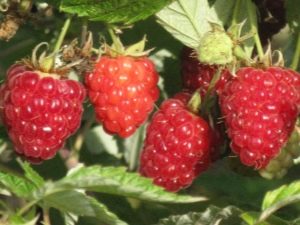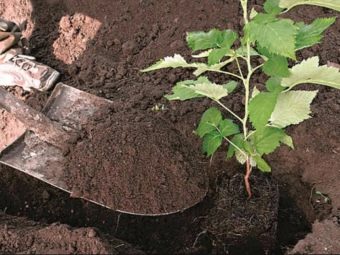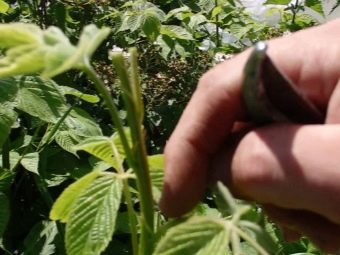Raspberry "Kirzhach": what kind of variety and what are its advantages?

Raspberry "Kirzhach" is very popular among gardeners. This is primarily due to the ease of growing and caring for shrubs.What kind of variety it is and what are its advantages - let's consider in more detail in this article.
History of origin
The variety "Kirzhach" was bred not long ago and belongs to the class of raspberry ordinary. Registration and description of the variety in the state register dates back to 1994. "Kirzhach" was obtained by crossing the varieties "Carnival" and "Molling Promis". The selection process was led by professor and doctor of biological sciences Viktor Kichin.
Raspberry "Kirzhach" at the time of breeding was the only one of all varieties, which fruited large berries. Now the shrub is not particularly stands out against the background of a large variety of species.
Initially, the variety was actively grown in the North-West and Volga-Vyatka regions, as well as in the territories of the North Caucasus and Ukraine. Over time, the raspberry "Kirzhach" has become more widespread and can be used in any areas where the winters are not very severe.
Features and specifications
Raspberry "Kirzhach" does not have any obvious features in comparison with other varieties. The shrub is widely used by amateur growers to produce berries for personal use, but not for mass production. The size of the berries refers to the average size.
The taste characteristics of the fruit is pretty good, but inferior to some types of raspberry. However, this does not make the Kirzhach variety less popular. This can be explained by ease in the care of shrubs and good yields.
If you describe the appearance of the variety, the shrub is characterized as powerful and tall. The length of the branches can reach 250 cm. Shrub belongs to the category of straight-growing plants. The variety is characterized by intensive formation of shoots: about 25 pieces per square meter. On the stems there is a small number of thorns purple hue.
In the shade, the stems have a green tint, and the sun turns purple-red. Kirzhach bears fruits of medium-large size, which have a blunt-conical shape. Fruits do not have a pronounced aroma. The soft part of the fruit is sweet, with a weak sour taste.
The shrub is also characterized by abundant fruiting. Raspberry "Kirzhach" is resistant to non-severe winters and tolerates thaw well. Also, the variety is undemanding to the soil and unpretentious in the care.
Diseases
The variety "Kirzhach" is distinguished by its average resistance to some common plant diseases. The shrub is practically not affected by the following diseases:
- defeat spider and raspberry mite;
- disease caused by deuteromycetes.
However, a number of diseases pose a great threat to the shrub. Raspberry "Kirzhach" has poor resistance to the following diseases:
- mycoplasma overgrowth;
- defeat by the pest beetle common raspberry;
- root cancer.
Mycoplasma overgrowth is expressed by the active point-like appearance of weak shoots instead of one strong stem. These stems are characterized by a small height - up to 30 cm - and a small diameter.
Weak shoots do not develop and do not bear fruit. In case of occurrence of this disease, it is recommended to dig up the bush completely.
The raspberry beetle damages the leaves and buds of raspberries. Pest larvae feed on the pulp of the berries. As a result of damage to the flowers, the shrub begins to bear fruit poorly, and the berries themselves develop poorly.
Root cancer belongs to the category of bacterial diseases in which the root system is affected. The shrub stops growing and bears fruit badly. Upon detection of this disease, the affected bushes need to dig and burn.
Advantages and disadvantages
Like any sort of raspberry, "Kirzhach" has its own advantages and disadvantages. Among the advantages of this type are the following:
- Fruits have a fairly good density, and therefore the transportation or storage of berries is not particularly difficult.
- Good taste of berries. The taste and aroma of the fruit resemble forest raspberries.
- The shrub is undemanding to fertile soil.
- Good yield. According to reviews of gardeners, from one bush can be collected from 3 to 5 kg of berries.
- This raspberry variety does not require complex care.
However, the variety "Kirzhach" has some drawbacks. Select the main disadvantages of this raspberry:
- the size of the fruit is not as large as that of some modern raspberry varieties;
- shrub does not tolerate severe frosts;
- the variety is not used for growing berries on an industrial scale.
How to plant and grow?
Planting and growing the Kirzhach raspberry will not cause any particular difficulties even for inexperienced gardeners. Observing some recommendations for the care of shrubs, you can ensure high yields of raspberries for many years.
Timing and landing scheme
The Kirzhach raspberry is planted taking into account the climate in the region. If the winters are quite severe, then it is best to plant shrubs in the spring. In regions with a mild climate, you can land in the fall. When choosing a place for raspberries, it is necessary to take into account a number of simple recommendations:
- The site should be well lit by sunlight. This is necessary for uniform and rapid ripening of berries.
- Shrubs should be protected from strong winds.
- It should be borne in mind that the “Kirzhach” raspberry is quite high and can cast a large shadow, so you should not plant a bush near the beds.
- Do not plant raspberries near water bodies, as this can lead to frequent shrub diseases.
Planted raspberries in one or several rows in holes dug beforehand. No need to place bushes too close to each other. The distance between seedlings in the same row should be about 40 centimeters, and between two adjacent rows - 50. The size of the gaps can be slightly larger if the free area allows it.
The root system of the shrub should go into the soil to a depth of three centimeters. It is advisable to put humus in the wells and process raspberry roots with wood ash to prevent bacterial diseases. Immediately after the landing of raspberries is recommended to cover the soil with mulch.
Watering
The growth rate of the shrub depends on the development of the root system. Roots need regular watering, especially during the period of active growth (late May - early June). Without watering, the shrub can develop incorrectly: a lot of stems and leaves appear, which, in turn, negatively affects the yield.
It should be borne in mind that the root system of raspberry spreads not only in width, but also goes into the soil by about 30 cm. Thus, water must penetrate into the soil to a depth of 35 cm. In order to irrigate a well one meter long, 20 liters of water will be required.
After watering the soil is recommended to loosen well, in order to avoid the formation of a crust on the surface. Watering raspberries is recommended no more than twice a month. The exception is the hot climate in the region or dry summer. In this case, watering is carried out three times a month, starting in mid-May and ending in late August.
Processing and feeding
Raspberry "Kirzhach" is undemanding to fertilizers and can get all the necessary trace elements from the soil. However, periodic feeding will not be superfluous for this variety, as it can significantly improve the yield. Fertilizing raspberries, it is important to consider the order of use of fertilizers.
In spring, it is recommended to loosen the soil in the raspberry-planted area, followed by the introduction of cow manure into the soil. Usually, 8 kg of manure are taken per square meter. In the first spring, the shrub especially needs feeding with urea. It is taken in a proportion of 20 grams per 10 liters of water. Fertilizer has a good effect on the growth of stems, and also contributes to their strengthening.
When the shrub enters the flowering phase, it must be treated with orthoboric acid. To prepare the correct solution will need to dilute 20 grams of the substance in a large bucket of water.
When berries begin to appear on the shrub, it must be treated with mineral fertilizer, for example, nitrophoska. To do this, prepare a solution of 30 grams of the substance and 10 liters of water, which is watered with raspberries. In the autumn it is recommended to dig up the soil or loosen it well. During this period, mineral phosphate fertilizer and potassium chloride are introduced into the soil.
Also, do not forget about the treatment of raspberries from common diseases and pests. For these purposes, a solution is prepared from the insecticide "Fufanon" (2 grams), the fungicide "Ridomil Gold" (25 grams) and 10 liters of water.
Pruning
It is recommended to prune raspberries in the spring period immediately after snow melts. Pruning is necessary to remove unhealthy or weak shoots that interfere with the proper growth of the shrub and good fruiting. When the shrub grows heavily, some healthy stems also need to be removed.
Dried or poorly developed branches are removed by soil level. When pruning, it is important to ensure that a part of the trimmed stem does not protrude on the ground surface. Otherwise, the risk of the shrub becoming infected with bacteria or infections increases.
When the first signs of disease are detected, the shoots must be removed immediately, in order to avoid the spread of infection throughout the shrub.
In the case of strong growth of the shrub, part of the healthy shoots are also subject to pruning. This is necessary for a good harvest. It is recommended to leave no more than 10 strong healthy stems on one shrub.
Garter
Garter bushes is of great importance when growing raspberries. Trellis or ordinary wooden pegs can be used as a support structure. Tied up shrubs do not actively grow in width, are more resistant to drafts and strong winds, and bear fruit better. In addition, the risk of bacteria damage to tied bushes is much lower.
To make the simplest support structure, you will need metal pipes or wooden sticks that are more than two meters long. The pillars are set along the plantations in 4 meter increments. Through the supporting elements it is necessary to stretch two or three rows of metal wire. It is also allowed to use twine instead of wire. Ropes should be at a distance of 70 centimeters and 140 centimeters from the ground.
Preparing for the winter
Malina "Kirzhach" badly tolerates severe frosts. Therefore, it is important to properly prepare the shrub for wintering. In the autumn, before the onset of frost, it is necessary to mulch the soil. Sawdust, hay, shredded bark of trees or needles can be used as mulch. In this case, the layer of the selected material should not be less than 20 cm.
To protect the root system from freezing, raspberry shoots for the winter must be bent and tied up near the ground. For such a garter also used trellis. The lowest wire in this case should be at a distance of 30-50 cm from the ground. It is to this row that the bind shoots will be tied up.
If the region has severe winters, then simply bending the branches will not be enough. In this case, it will be necessary to construct special barriers against strong wind and heavy rainfall or to use covering material. The protective structure can be made of moisture resistant plywood or polycarbonate.








































